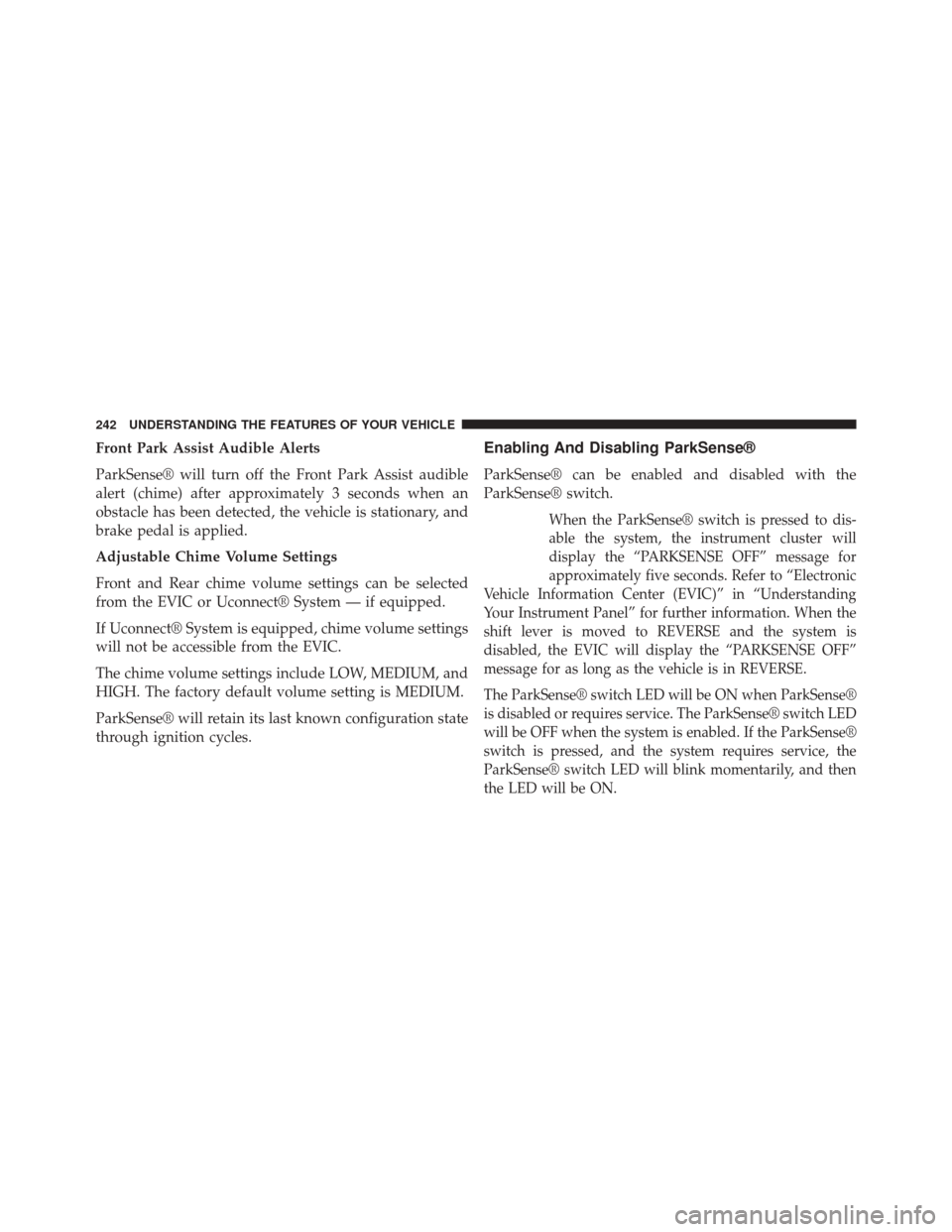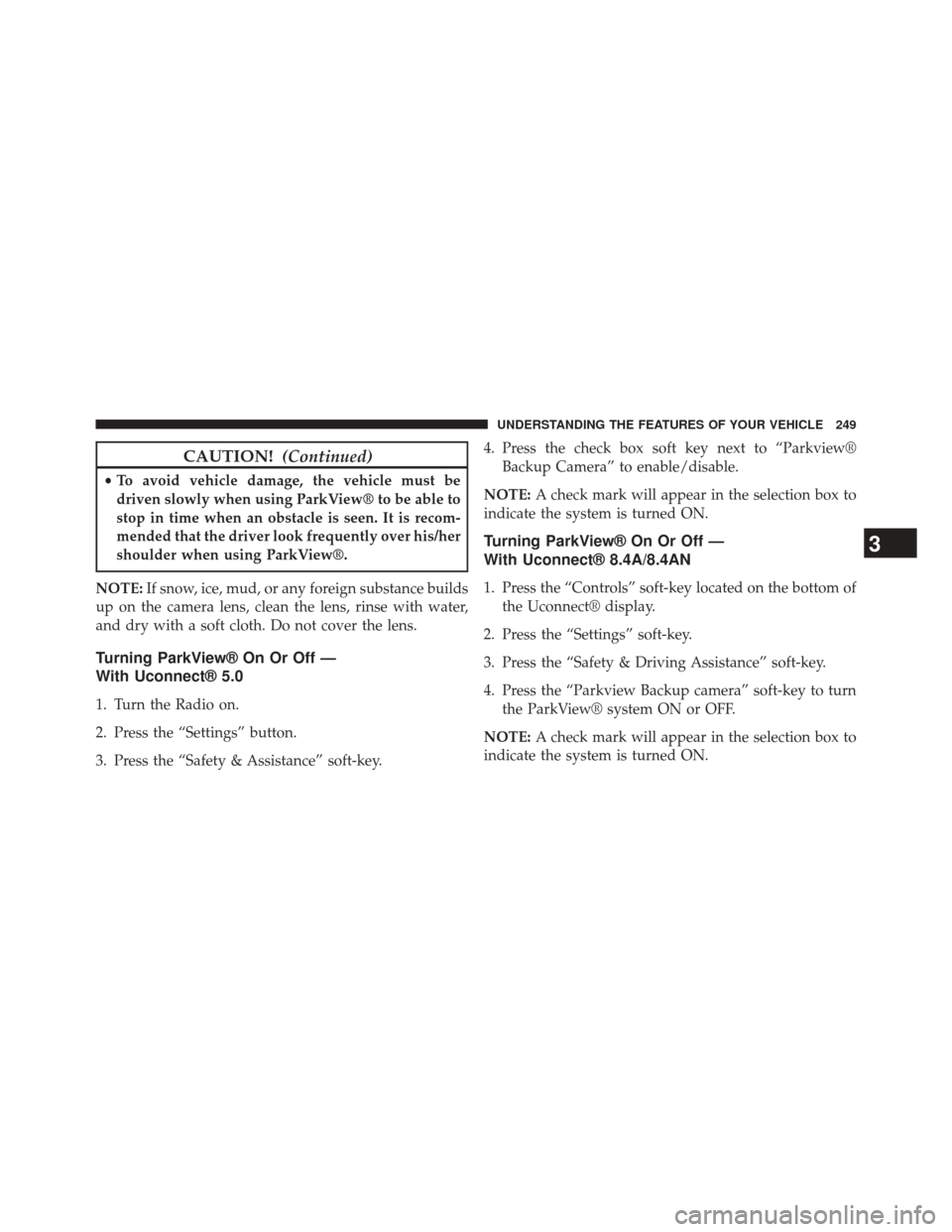Page 241 of 615
If an object is detected in the left and/or right rear region,
the display will show a single arc in the left and/or right
rear region and the system will produce a tone. As the
vehicle moves closer to the object, the display will show
the single arc moving closer to the vehicle and the tone
will change from a single 1/2 second tone to slow, to fast,
to continuous.
Single 1/2 Second Tone
Slow Tone
3
UNDERSTANDING THE FEATURES OF YOUR VEHICLE 239
Page 243 of 615
The vehicle is close to the obstacle when the EVIC display
shows one flashing arc and sounds a continuous tone.
The following chart shows the warning alert operation
when the system is detecting an obstacle:
WARNING ALERTS
Rear Distance (in/cm) Greater than 79
in (200 cm) 79-39 in
(200-100 cm) 39-25 in
(100-65 cm) 25-12 in
(65-30 cm) Less than 12 in
(30 cm)
Front Distance (in/cm) Greater than 47
in (120 cm) 47-39 in
(120-100 cm) 39-25 in
(100-65 cm) 25-12 in
(65-30 cm) Less than 12 in
(30 cm)
Audible Alert (Chime) None Single 1/2
Second Tone
(for rear only) Slow (for rear
only) Fast
Continuous
Arcs None4th Solid 3rd Solid 2nd Flashing 1st Flashing
Radio Volume Reduced No
Yes YesYes Yes
NOTE: ParkSense® will reduce the volume of the radio,
if on, when the system is sounding an audio tone.
3
UNDERSTANDING THE FEATURES OF YOUR VEHICLE 241
Page 244 of 615

Front Park Assist Audible Alerts
ParkSense® will turn off the Front Park Assist audible
alert (chime) after approximately 3 seconds when an
obstacle has been detected, the vehicle is stationary, and
brake pedal is applied.
Adjustable Chime Volume Settings
Front and Rear chime volume settings can be selected
from the EVIC or Uconnect® System — if equipped.
If Uconnect® System is equipped, chime volume settings
will not be accessible from the EVIC.
The chime volume settings include LOW, MEDIUM, and
HIGH. The factory default volume setting is MEDIUM.
ParkSense® will retain its last known configuration state
through ignition cycles.Enabling And Disabling ParkSense®
ParkSense® can be enabled and disabled with the
ParkSense® switch.
When the ParkSense® switch is pressed to dis-
able the system, the instrument cluster will
display the “PARKSENSE OFF” message for
approximately five seconds. Refer to “Electronic
Vehicle Information Center (EVIC)” in “Understanding
Your Instrument Panel” for further information. When the
shift lever is moved to REVERSE and the system is
disabled, the EVIC will display the “PARKSENSE OFF”
message for as long as the vehicle is in REVERSE.
The ParkSense® switch LED will be ON when ParkSense®
is disabled or requires service. The ParkSense® switch LED
will be OFF when the system is enabled. If the ParkSense®
switch is pressed, and the system requires service, the
ParkSense® switch LED will blink momentarily, and then
the LED will be ON.
242 UNDERSTANDING THE FEATURES OF YOUR VEHICLE
Page 245 of 615

Service The ParkSense® Park Assist System
During vehicle start up, when the ParkSense® System
has detected a faulted condition, the instrument cluster
will actuate a single chime, once per ignition cycle, and it
will display the�PARKSENSE UNAVAILABLE WIPE
REAR SENSORS�, �PARKSENSE UNAVAILABLE WIPE
FRONT SENSORS�,orthe�PARKSENSE UNAVAIL-
ABLE SERVICE REQUIRED� message for five seconds.
When the shift lever is moved to Reverse and the system
has detected a faulted condition, the EVIC will display a
�PARKSENSE UNAVAILABLE WIPE REAR SENSORS �,
�PARKSENSE UNAVAILABLE WIPE FRONT SENSORS �
or �PARKSENSE UNAVAILABLE SERVICE REQUIRED�
pop up message for five seconds. After five seconds, a car
graphic will be displayed with �UNAVAILABLE�at ei-
ther the front or rear sensor location depending on where
the fault is detected. The system will continue to provide
arc alerts for the side that is functioning properly. These arc alerts will interrupt the
�PARKSENSE UNAVAIL-
ABLE WIPE REAR SENSORS�, �PARKSENSE UNAVAIL-
ABLE WIPE FRONT SENSORS�,or�PARKSENSE
UNAVAILABLE SERVICE REQUIRED� messages if an
object is detected within the five second pop-up duration.
The car graphic will remain displayed for as long as the
vehicle is in REVERSE. Refer to “Electronic Vehicle
Information Center (EVIC)” in “Understanding Your
Instrument Panel” for further information.
If �PARKSENSE UNAVAILABLE WIPE REAR SENSORS�
or �PARKSENSE UNAVAILABLE WIPE FRONT SEN-
SORS� appears in the Electronic Vehicle Information
Center (EVIC) make sure the outer surface and the
underside of the rear fascia/bumper and/or front fascia/
bumper is clean and clear of snow, ice, mud, dirt or other
obstruction and then cycle the ignition. If the message
continues to appear see an authorized dealer.
3
UNDERSTANDING THE FEATURES OF YOUR VEHICLE 243
Page 246 of 615

If the�PARKSENSE UNAVAILABLE SERVICE RE-
QUIRED� message appears in the EVIC, see an autho-
rized dealer.
Cleaning The ParkSense® System
Clean the ParkSense® sensors with water, car wash soap
and a soft cloth. Do not use rough or hard cloths. Do not
scratch or poke the sensors. Otherwise, you could dam-
age the sensors.
ParkSense® System Usage Precautions
NOTE:
• Ensure that the front and rear bumper are free of snow,
ice, mud, dirt and debris to keep the ParkSense®
system operating properly.
• Jackhammers, large trucks, and other vibrations could
affect the performance of ParkSense®. •
When you turn ParkSense® off, the instrument cluster
will display “PARKSENSE OFF.” Furthermore, once
you turn ParkSense® off, it remains off until you turn
it on again, even if you cycle the ignition key.
• When you move the shift lever to the REVERSE
position and ParkSense® is turned off, the instrument
cluster will display “PARKSENSE OFF” for as long as
the vehicle is in REVERSE.
• ParkSense®, when on, will reduce the volume of the
radio when it is sounding a tone.
• Clean the ParkSense® sensors regularly, taking care
not to scratch or damage them. The sensors must not
be covered with ice, snow, slush, mud, dirt or debris.
Failure to do so can result in the system not working
properly. The ParkSense® system might not detect an
obstacle behind or in front of the fascia/bumper, or it
could provide a false indication that an obstacle is
behind or in front of the fascia/bumper.
244 UNDERSTANDING THE FEATURES OF YOUR VEHICLE
Page 247 of 615

•Use the ParkSense® switch to turn the ParkSense®
system off if objects such as bicycle carriers, trailer
hitches, etc. are placed within 12 in (30 cm) from the
rear fascia/bumper. Failure to do so can result in the
system misinterpreting a close object as a sensor
problem, causing the “PARKSENSE UNAVAILABLE
SERVICE REQUIRED” message to be displayed in the
instrument cluster.
• On vehicles equipped with a tailgate, ParkSense®
should be disabled when the tailgate is in the lowered
or open position. A lowered tailgate could provide a
false indication that an obstacle is behind the vehicle.
• There may be a delay in the object detection rate if the
object is moving. This will cause the automatic braking
application to be delayed.CAUTION!
• ParkSense® is only a parking aid and it is unable to
recognize every obstacle, including small obstacles.
Parking curbs might be temporarily detected or not
detected at all. Obstacles located above or below
the sensors will not be detected when they are in
close proximity.
• The vehicle must be driven slowly when using
ParkSense® in order to be able to stop in time
when an obstacle is detected. It is recommended
that the driver looks over his/her shoulder when
using ParkSense®.
3
UNDERSTANDING THE FEATURES OF YOUR VEHICLE 245
Page 249 of 615

PARKVIEW® REAR BACK UP CAMERA —
IF EQUIPPED
Your vehicle may be equipped with the ParkView® Rear
Back Up Camera that allows you to see an on-screen
image of the rear surroundings of your vehicle whenever
the shift lever is put into REVERSE. The image will be
displayed on the Navigation/Multimedia radio display
screen along with a caution note to “check entire sur-
roundings” across the top of the screen. After five sec-
onds this note will disappear. The ParkView® camera is
located on the rear of the vehicle above the rear License
plate.
When the vehicle is shifted out of REVERSE (with camera
delay turned OFF), the rear camera mode is exited and
the navigation or audio screen appears again.When the vehicle is shifted out of REVERSE (with camera
delay turned ON), the rear view image with dynamic
grid lines will be displayed for up to 10 seconds after
shifting out of
�REVERSE�unless the forward vehicle
speed exceeds 8 mph (13 km/h), the transmission is
shifted into �PARK�or the ignition is switched to the OFF
position.
When enabled, active guide lines are overlaid on the
image to illustrate the width of the vehicle and its
projected backup path based on the steering wheel
position. The active guide lines will show separate zones
that will help indicate the distance to the rear of the
vehicle while a dashed center-line will indicate the center
of the vehicle to assist with aligning to a hitch/receiver.
3
UNDERSTANDING THE FEATURES OF YOUR VEHICLE 247
Page 251 of 615

CAUTION!(Continued)
•To avoid vehicle damage, the vehicle must be
driven slowly when using ParkView® to be able to
stop in time when an obstacle is seen. It is recom-
mended that the driver look frequently over his/her
shoulder when using ParkView®.
NOTE: If snow, ice, mud, or any foreign substance builds
up on the camera lens, clean the lens, rinse with water,
and dry with a soft cloth. Do not cover the lens.
Turning ParkView® On Or Off —
With Uconnect® 5.0
1. Turn the Radio on.
2. Press the “Settings” button.
3. Press the “Safety & Assistance” soft-key. 4. Press the check box soft key next to “Parkview®
Backup Camera” to enable/disable.
NOTE: A check mark will appear in the selection box to
indicate the system is turned ON.
Turning ParkView® On Or Off —
With Uconnect® 8.4A/8.4AN
1. Press the “Controls” soft-key located on the bottom of the Uconnect® display.
2. Press the “Settings” soft-key.
3. Press the “Safety & Driving Assistance” soft-key.
4. Press the “Parkview Backup camera” soft-key to turn the ParkView® system ON or OFF.
NOTE: A check mark will appear in the selection box to
indicate the system is turned ON.
3
UNDERSTANDING THE FEATURES OF YOUR VEHICLE 249